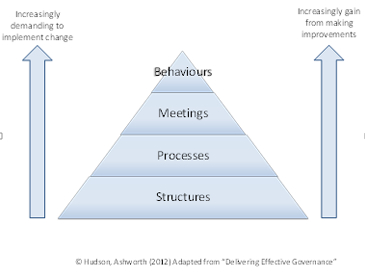If you want to run a successful board meeting, start with a successful agenda, says Denise Fellows of Cass Business School.
I sit on a number of charity boards, both as chief executive and as trustee and I have, on occasion, been known to need a stiff drink when I get home (tea, two sugars obviously!). Most of us will have heard anecdotes about sitting through hours of rambling discussions and presentations, with trustees wondering why they are there and what they are contributing.
Depressingly many good trustees will turn tail and run after a few dire meetings, however committed they may be to the cause. Well run meetings are an essential part of good governance and being able to make strategic change within charities, and the best board meetings start with a well-planned agenda, to ensure that trustees are able to contribute meaningfully.
The Compass Cass Governance model (pictured below) was developed from the analysis of data of a survey into the governance of the top 500 charities and defines a hierarchy of needs for good governance starting with structures (board size, sub committees, terms of office), processes (chair and trustee selection, induction), meetings (more below) and behaviours (openness and trust, strategic challenge).

The survey shows that boards typically meet between three and six times a years, although smaller charities (and boards) may meet more regularly and sometimes once a month. It is usual for board meetings to be less than 3 hours excepting for one away day a year. Over two-thirds of those surveyed said that their chief executive and chair planned board agendas together either extremely or very systematically.
At our recent seminar series around Building Better Governance we explored how to develop board agendas to stimulate high quality decisions:
- Have an annual board calendar to ensure that items such as the risk register, appointment of trustees, policies (such as for reserves or investment) and a planned away day are scheduled for the year.
- In pre-planning the agenda, the chief executive and chair decide: what do we want to achieve at this meeting? How do we best structure it to get results? On what topics and issues can Board members best add value?
- Allow time needed for each item: put the substantive items early and allocate a significant amount of time to the topics that really matter. Use a consent agenda for routine business, such as agreeing previous meeting minutes, routine updates that are covered by submitted summary reports and Sub-committee updates where no decisions are required.
- Have the agenda follow the strategy: structure things around the strategic priorities. Make it clear whether an item is for: information, discussion or decision. Discussion is important and allows trustees to explore a question. If possible any associated decisions should be left to a future meeting, so there is time to reflect so trustees can make the links between the strategy and the meeting decisions.
- Always save 10 minutes at the end of the meeting to explore what worked well and the learning for next time.
Making change is a slow process and it is worth reflecting in the planning that it can take three meetings to get a major decision through a board meeting - the first to raise for information, the second for discussion and the third to make the decision.
The result of a well-planned agenda will be trustees who are engaged and supportive and most importantly - the good trustees will still be on board.
(With acknowledgements to Caroline Copeman at Cass CCE and Cathy Trower’s guide for board agendas).








